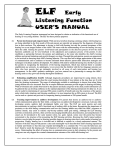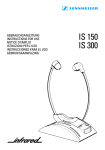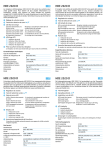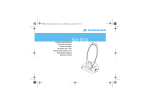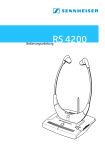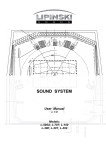Download Sennheiser 830 S Headphones User Manual
Transcript
cordless TV listening system Set 830 S Instruction manual I 1 7 7 2 3 4 5 6 Q II D 8 C 9 B 0 A E F G H Contents Contents Safety instructions ................................................................. 2 Delivery includes ..................................................................... 4 Product overview .................................................................... 5 Putting the Set 830 S into operation ................................. 6 Setting up the transmitter ............................................... 6 Connecting the transmitter to a sound source ............ 7 Connecting the transmitter to the mains ................... 10 Wearing the receiver around the neck ........................ 11 Attaching the receiver to clothing ................................ 11 Connecting headphones or the induction loop for hearing aids to the receiver ..................................... 12 Using the Set 830 S .............................................................. 13 Switching the transmitter on/off ................................. 13 Switching the receiver on/off ........................................ 14 Adjusting the volume ...................................................... 14 Searching for a sound source ......................................... 15 Adjusting the balance ..................................................... 15 Switching between mono and stereo operation ........ 16 Individually enhancing the speech intelligibility ....... 17 Storing and charging the receiver ................................ 18 Charging a rechargeable battery in the transmitter’s charging compartment .......................... 19 What if... ................................................................................. 20 ...this indicator lights up? ............................................... 20 ...you press this button? ................................................. 20 ...you change the position of this control/switch? .... 21 ...you hear acoustic signals or warning signals? ........ 21 Cleaning the Set 830 S ........................................................ 23 Cleaning the transmitter and the receiver .................. 23 If a problem occurs ... ........................................................... 23 Additional technical information ...................................... 26 Accessories and spare parts ............................................... 29 Specifications ........................................................................ 31 Manufacturer Declarations ................................................. 33 Index ........................................................................................ 34 1 Safety instructions Safety instructions • Please read this instruction manual carefully and completely before using the devices. • Make this instruction manual easily accessible to all users at all times. Always include this instruction manual when passing the devices on to third parties. • Do not use the devices in situations which require special attention (e.g. when performing skilled jobs). • Always keep the devices dry and do not expose them to extreme temperatures. • Use the devices with care and set them up in a clean, dust-free environment. • Varnish or furniture polish may degrade the feet of the transmitter, which could stain your furniture. You should therefore place the transmitter on a non-slip pad to avoid potential staining of furniture. • This receiver allows you to set higher volumes than conventional headphones. This can cause hearing damage in persons with healthy hearing and especially in children. • Refer all servicing to qualified service personnel. Servicing is required if the devices have been damaged in any way, such as mains cable or plug damage, liquid has been spilled, objects have fallen inside, the devices have been exposed to rain or moisture, do not operate properly or have been dropped. • WARNING: To reduce the risk of fire or electric shock, do not expose the device and the mains unit to rain or moisture. • Use only the supplied mains unit. • Disconnect the mains connector from the wall socket – to completely disconnect the device from the mains, – during lightning storms or when unused for long periods of time. • Ensure that the mains unit is: – always readily operable and easily accessible, – properly plugged into the wall socket, – not covered or exposed to direct sunlight for longer periods of time in order to prevent heat accumulation, – only operated within the permissible temperature range (see “Specifications” on page 31), – not operated near heat sources. 2 Safety instructions Intended use of the devices Intended use includes: • having read this instruction manual, especially the chapter “Safety instructions”, • using the devices within the operating conditions and limitations described in this instruction manual. “Improper use” means using the devices other than as described in this instructions, or under operating conditions which differ from those described herein. Safety instructions for the Lithium-Ion rechargeable battery The BA 300 is a Lithium-Ion rechargeable battery. If abused or misused, this rechargeable battery may be damaged. Please understand that Sennheiser does not accept liability for damage arising from abuse or misuse. WARNING! ! In extreme cases, the rechargeable battery may even present a • heat hazard • fire hazard • explosion hazard • smoke and gas hazard Do not heat above 70°C/158°F, e.g. do not expose to sunlight or throw into a fire. Only charge rechargeable batteries with the appropriate Sennheiser chargers. Do not expose to moisture. When not using the rechargeable battery for extended periods of time, charge it regularly (every six months for about one hour). Do not short-circuit. Only charge rechargeable batteries at ambient temperatures between 10°C and 40°C. Do not mutilate or dismantle. Do not charge the rechargeable battery if the device is obviously defective. Store the devices/ rechargeable batteries in a cool and dry place at room temperature. Return defective devices or devices with defective rechargeable batteries to your specialist dealer. 3 Delivery includes Delivery includes Delivery of the Set 830 S system includes: 1 RI 830 S receiver with BA 300 Lithium-Ion rechargeable battery 1 TI 830 transmitter with integrated charging compart-ments 1 EZT 3011 induction loop 1 NT 13 mains unit with 3 country adapters (EU, UK, US) 1 connection cable with two 3.5 mm stereo jack plugs for connection to a headphone socket 3 audio adapters: 1 adapter 3.5 mm to ¼” (6.3 mm) jack plug 1 adapter for RCA socket 1 SCART adapter for SCART socket 1 lanyard 1 clip for attaching the receiver 1 instruction manual 4 Product overview Product overview I 1 2 3 4 II Receiver (see inside cover) Channel indicator Volume control On/off button Balance control 5 Channel search button 6 Battery compartment 7 Socket for headphones, induction loop or connection cable to hearing aid Transmitter (see inside cover) 8 Charging compartment for receiver 9 Charging compartment for optional spare 0 A B C D E F G H rechargeable battery Charging indicator for optional spare rechargeable battery Charging indicator for receiver’s rechargeable battery Operation indicator “Speech intelligibility” button Indicator for the selected speech intelligibility Socket (marked blue) for connection of sound source or external microphone Mono/stereo slide switch Treble adjustment control DC socket (marked yellow) for connection of mains unit 5 Putting the Set 830 S into operation Putting the Set 830 S into operation Setting up the transmitter 왘 Place the transmitter so that: – there are no obstacles in the light path between transmitter and receiver and – transmitter and receiver are not exposed to direct sunlight. Direct sunlight may interfere with the reception and may damage the transmitter. If you are using a plasma TV screen: Plasma TV screens radiate an infra-red signal that can adversely affect the transmission quality. 왘 Make sure that the transmitter is placed as far as possible from your plasma TV screen. 왘 If necessary, use a standard extension cable (3.5 mm stereo jack plug) to reduce the distance between transmitter and receiver. This extension cable is available from your Sennheiser dealer. Note: One transmitter can be used to transmit to several receivers on the same frequency. 6 Putting the Set 830 S into operation Connecting the transmitter to a sound source 왘 Switch your sound source (e.g. TV) off before connecting the transmitter. I E 왘 Plug one end of the connection cable I into the blue socket E on the transmitter. 왘 Check the connection possibilities of your sound source (e.g. TV). Connection possibility A B C D Socket on L R – sound source Name of Head- RCA SCART MKE 800 TV-N connection phone socket socket* external possibility socket microphone* 왘 Select one of the four connection possibilities A , B , C or D and follow the instructions in the corresponding chapter. Note: If there are several connections ( A , B or C ) available, select the SCART socket C . * SCART adapter and microphone are also available as accessories (see page 29). 7 Putting the Set 830 S into operation A Connecting the transmitter to a headphone socket J 왘 I Plug the other end of the connection cable I into the head-phone socket on your sound source. Is the plug on the connection cable too small for the headphone socket? 왘 왘 Plug the adapter to ¼” (6.3 mm) jack socket J onto the connection cable I. Adjust the volume of the headphone socket on your sound source to a medium level. This improves the quality of cordless sound transmission. For detailed information, please refer to the instruction manual of your sound source (e.g. TV). Note: With most TVs, the headphone socket is located at the front or sides. B Connecting the transmitter to an RCA socket K I 왘 Plug the adapter for RCA socket K onto the connection cable I. 왘 Connect the red connector of the adapter K to the red RCA socket R of your sound source. 왘 Connect the white connector of the adapter K to the white or black RCA socket L of your sound source. Note: With most TVs, the RCA socket is located at the rear. 8 Putting the Set 830 S into operation C Connecting the transmitter to a SCART socket I L 왘 Plug the SCART adapter L onto the connection cable I. 왘 Connect the SCART adapter L to the SCART socket on your TV. Note: If your TV has several SCART sockets, use the socket SCART output. D Using the MKE 800 TV-N external microphone Your sound source doesn’t have any of the connections mentioned above? You can then use the MKE 800 TV-N microphone (see “Accessories and spare parts” on page 29). 왘 Directly connect the microphone to the blue socket E on the transmitter. 왘 Position the microphone in front of the loudspeaker of your sound source. Note: You can change the sound by varying the position of the microphone in front of the loudspeaker. 9 Putting the Set 830 S into operation Connecting the transmitter to the mains M N EU UK 왘 Select the suitable country adapter N for your wall socket. 왘 Plug the suitable country adapter onto the mains unit M. 왘 Connect the yellow connector of the mains unit to the yellow socket H on the transmitter. 왘 Plug the mains unit M into a wall socket. The operation indicator B on the transmitter lights up green. US H M Notes: – When connecting the transmitter to the mains for the first time, charge the rechargeable battery for 3 hours as described in the chapter 3h “Storing and charging the receiver” on page 18. – If there is no audio signal from the sound source for about 3 minutes, the transmitter automatically switches off. The operation indicator B goes off. 10 Putting the Set 830 S into operation Wearing the receiver around the neck Use the supplied lanyard P or induction loop Q to wear the receiver around your neck. Note: If you want to use the receiver with your hearing aid, attach the induction loop instead of the lanyard. P 왘 If necessary, remove the attachment clip O from the receiver. 왘 Connect the fasteners of the lanyard P to the metal ring at the rear of the receiver. 왘 Wear the receiver around your neck, with the Sennheiser logo facing away from your body. Attaching the receiver to clothing O 왘 Attach the clip O or the clip of the induction loop to the receiver as shown. 왘 Attach the clip O to your clothing or belt. O 11 Putting the Set 830 S into operation Connecting headphones or the induction loop for hearing aids to the receiver The socket 7 on the receiver allows you to connect • headphones, • the induction loop Q or • a connection cable to your hearing aid. 7 왘 Connect the corresponding cable to the socket 7 on the receiver. 7 Q If you want to connect the induction loop Q to the receiver: 왘 Set your hearing aid to position “T”. If your hearing aid has no position “T”, please contact your hearing aid acoustician. Note: For alternative connection possibilities to your hearing aid as well as the connection to cochlea implants, please contact your hearing aid acoustician. 12 Using the Set 830 S Using the Set 830 S To switch the Set 830 S system on, proceed as follows: 1. Switch your sound source (e.g. TV) on. The transmitter automatically switches on (see next chapter). 2. Switch the receiver on (see page 14). 3. Adjust the desired volume (see page 14). Switching the transmitter on/off To switch the transmitter on: 왘 Switch your sound source on. The transmitter automatically switches on. The operation indicator B lights up green. The transmitter doesn’t switch on? 왘 Read the chapter “If a problem occurs ...” on page 23. To switch the transmitter off: 왘 Switch your sound source off. The transmitter automatically switches off after 3 minutes. The operation indicator B goes off. To disconnect the transmitter from the mains: 왘 Pull out the mains connector from the wall socket. Note: When not using the transmitter for extended periods of time (e.g. when you are on holiday), pull out the mains connector from the wall socket. In this case, however, the receiver’s rechargeable battery will not be recharged. 13 Using the Set 830 S Switching the receiver on/off CAUTION! Hearing damage due to high volumes! This receiver allows you to set higher volumes than conventional headphones. This can cause hearing damage in persons with healthy hearing and especially in children. 왘 Before using the receiver, set the volume on the receiver to a low value. 왘 Do not continuously expose yourself to high volumes. Switching the receiver on 1 왘 3 Press the on/off button 3 for 2 seconds. The channel indicator 1 lights up. Switching the receiver off 왘 Press the on/off button 3. The channel indicator 1 goes off. Notes: – For how to store and charge the receiver, see page 18. – If you are not within the range of the transmitter, the receiver automatically switches off after 3 minutes. 3h Adjusting the volume 왘 14 Use the volume control 2 to adjust the volume to a sufficient and comfortable level. Using the Set 830 S Searching for a sound source 왘 Switch the receiver on. Do you hear the desired sound source? Yes: The receiver has already found the sound source. 1 5 No: 왘 Briefly press the channel search button 5. The sound source is searched for. On the receiver, the channel indicator 1 can light up as follows: Channel indicator Frequency 2.3+2.8 MHz You hear the sound in stereo 2.3 MHz 2.8 MHz mono 왘 If you still haven’t found your sound source, press the channel search button once more. You cannot find your sound source? 왘 Read the chapter “If a problem occurs ...” on page 23. Note: The channel indicator goes off after 30 seconds so that the light won’t disturb you in a dark room. Adjusting the balance 4 The balance control allows for right/left volume adjustment. Adjust the balance so that you hear equally well with both ears. 왘 Turn the balance control 4 to the left L or right R in order to increase the volume for the corresponding ear. 15 Using the Set 830 S Switching between mono and stereo operation If, despite a correct balance adjustment, you can hear the sound only with one ear: 왘 Set the ST/MO switch F on the transmitter to MO (mono). F Meaning of the terms “mono” and “stereo” Stereo (ST) L Mono (MO) R L+R Example: L: Speech from the left R: Music from the right You hear speech from You hear speech and music the left and music from coming from the front. the right. 16 Using the Set 830 S Individually enhancing the speech intelligibility D The “speech intelligibility” button allows you to adjust the sound to your individual needs. C C Try out which setting works best for you. 왘 Press the “speech intelligibility” button C sound is optimally adjusted to your needs. Press the button until the 1x 2x 3x 4x 1 2 3 Default setting Indicator D lit yellow Setting If necessary, you can have the speech intelligibility fine adjusted to your hearing ability (see page 26). 17 Using the Set 830 S Storing and charging the receiver 왘 B A After use, place the receiver into the transmitter’s charging compartment 8 without exerting too much pressure. 8 When the receiver is placed correctly into the charging compartment, the indicator A lights up: red: The battery is being charged. green: The battery is fully charged. Notes: – With a fully charged battery, the operating time is up to 12 hours. – If you have several receivers, they can be used during charging. – Always store the receiver in the transmitter’s charging compartment 8 to ensure that it is fully charged. The intelligent battery charging technology prevents overcharging. 18 Using the Set 830 S Charging a rechargeable battery in the transmitter’s charging compartment You can charge the receiver’s rechargeable battery or a spare BA 300 rechargeable battery (not included in the delivery of the Set 830 S) in the charging compartment 9 at the side of the transmitter. The spare battery offers extended listening time while the discharged first battery is being recharged. Note: Before using the spare rechargeable battery for the first time, charge it for at least 3 hours. 3h Removing and charging the receiver’s battery To remove the receiver’s battery: 왘 Pull the battery out of the receiver’s battery compartment 6. 왘 Insert the receiver’s battery into the charging compartment 9 at the side of the transmitter as shown. 6 9 0 When the battery is inserted correctly into the charging compartment, the indicator 0 lights up: red: The battery is being charged. green: The battery is fully charged. 왘 Slide the battery into the receiver’s battery compartment 6 as far as it will go. 6 19 What if... What if... ...this indicator lights up? Indicator Channel indicator 1 on the receiver Status lit yellow off Operation indicator B on the transmitter lit green Charging indicator A Charging indicator 0 lit red off lit green “Speech lit yellow intelligibility” indicator D on the transmitter off Meaning Receiver has just been switched on or a button has just been pressed. Receiver is switched on for more than 30 secs. and no button has been pressed. Receiver is switched off. Transmitter is switched on. Transmitter is switched off. Rechargeable battery is being charged. Rechargeable battery is fully charged. Speech intelligibility enhancement is switched on. Speech intelligibility enhancement is switched off. ...you press this button? Button Function Channel search button 5 on the receiver “Speech intelligibility” button C on the transmitter Searches for the sound source or a different channel. 20 Selects one of the possible settings in order to individually enhance the speech intelligibility. see page 15 17 What if... ...you change the position of this control/switch? Control/switch Function Volume control 2 Reduces or increases the volume of the receiver. on the receiver Balance control 4 Increases the volume for the left or the right ear. on the receiver see page 14 15 Mono/stereo slide Sets the transmitter to mono or stereo operation. switch F on the transmitter 16 Treble adjustment Treble adjustment is only to control G on the be made by a hearing aid technician / an expert. transmitter 27 ...you hear acoustic signals or warning signals? Acoustic signal 3 ascending beeps Meaning The receiver has just been switched on. 3 descending beeps The receiver has just been switched off. 1 acknowledgement beep The channel search button has been pressed once briefly. 1–2 short beeps The channel search button has been pressed for 6 seconds. The receiver is set to channel 1 or 2. 21 What if... Warning signal 6 short beeps 2 long beeps 5 Meaning The receiver does not receive any signal from the transmitter: • Transmitter and receiver are too distant. The receiver switches off after 3 minutes. • The transmitter is switched off. The rechargeable battery is almost flat. To switch the acoustic signals on and off: 왘 Press the channel search button 5 on the receiver for approx. 5 seconds. You hear a short acoustic signal. Note: Warning signals cannot be switched off. 22 Cleaning the Set 830 S Cleaning the Set 830 S Cleaning the transmitter and the receiver CAUTION! Liquids can damage the electronics of the devices! Liquids entering the housing of the devices can cause a short-circuit and damage the electronics. 왘 Keep all liquids far away from the devices. 왘 Do not use any cleansing agents or solvents. 왘 Before cleaning, disconnect the transmitter from the mains. 왘 Use only a slightly damp cloth to clean the devices. If a problem occurs ... The transmitter does not switch on Possible cause Solution Is the mains unit Check the connection of the mains connected correctly? unit to the transmitter and to the mains (see page 10). Is the sound source switched on? Is the volume of the sound source sufficient? Is the transmitter set to operating mode 2 (see page 28)? Switch your sound source on. Set the volume on your sound source to a medium value. Take the receiver out of the charging compartment. The transmitter automatically switches on. 23 If a problem occurs ... You cannot hear anything Possible cause Is there a free line of sight between receiver and transmitter? Are transmitter and receiver exposed to direct sunlight? Is the receiver still within the transmitter’s range? Solution Remove obstacles in the light path between receiver and transmitter. Avoid exposure to direct sunlight. Move the receiver closer to the transmitter. If necessary, switch the receiver on again. Are all connectors Check the connection between the connected correctly? transmitter and your sound source (see page 7). Is the operation Check if the transmitter is switched on (see page 13). indicator B lit? Is the transmitter set up the wrong way round? Does the receiver’s Sennheiser logo face the transmitter? Is the volume of the sound source sufficient? Is the volume of the receiver sufficient? Set up the transmitter so that the cables are guided away from the receiver (see page 6). Wear the receiver the right way round, with the Sennheiser logo facing the transmitter. Set the volume on your sound source to a medium value. Is the rechargeable battery inserted properly into the receiver and fully charged? Check if the channel indicator 1 is lit. If it is not lit: recharge the rechargeable battery (see page 19). Remove the rechargeable battery and reinsert it into the receiver. If this doesn’t help: recharge the rechargeable battery (see page 19). 24 Increase the volume by turning the volume control 2 on the receiver (see page 14). If a problem occurs ... You hear the sound only with one ear Possible cause Is the balance adjusted correctly? Is the transmitter set to mono? Solution Turn the balance control 4 to the left or right (see page 15). Set the mono/stereo switch F on the transmitter to the left (see page 16). The sound of your sound source is hardly intelligible Possible cause Is the speech intelligibility enhancement out of adjustment? Solution Press the “speech intelligibility” button C on the transmitter until the sound is optimally adjusted to your needs (see page 17). Do you use a Make sure that the transmitter is plasma TV screen? placed as far as possible from your plasma TV screen (see page 6). You do not hear the Press the channel search button 5 desired channel? on the receiver to restart the search for your desired channel. Is the receiver still Move the receiver closer to the within the transtransmitter. If necessary, switch mitter’s range? the receiver on again. 25 Additional technical information The loudspeakers of your TV are muted Possible cause Some TVs have a function that mutes the loudspeakers when you connect a transmitter. Solution Via the operating menu of your TV, check if and how the muting function can be deactivated. Use either a different audio socket on your TV or use the MKE 800 TV-N external microphone (see “Accessories and spare parts” on page 29). If a problem occurs that is not listed in the above tables or if the problem cannot be solved with the proposed solutions, please contact your Sennheiser partner for assistance. Additional technical information Fine adjusting the speech intelligibility The speech intelligibility can be enhanced individually on the transmitter (see page 17). There are the following settings: Setting Fine adjustment 1 Compression 2 Treble boost 3 Compression and treble boost Default setting 26 Indicator D lit yellow No fine adjustment made Additional technical information Compression (settings 1 and 3) Deterioration of the ability to hear quiet sounds as well as loud ones is a typical symptom of old age. Compression compensates for these volume differences by boosting the volume of quiet sounds and reducing the volume of loud sounds if necessary. Compression seems to put the speech in the foreground, making it easier to understand. Compression is self-regulating; once it has been activated, it is not necessary to make any other settings. Treble boost (settings 2 and 3) Another typical age-related phenomenon is the deterioration of the hearing with regard to high frequencies. However, high frequencies are important for the intelligibility of speech. The treble boost makes the speech clearer and easier to understand. With the treble boost (settings 2 and 3), additional fine adjustment is possible using the treble boost control G on the rear of the transmitter. G 왘 Use a screwdriver to turn the treble boost control G to the left or right until the sound can be heard very well. The position “0” corresponds to a minimum boost, the position “MAX” corresponds to a maximum boost, and the control is factorypreset to the medium position. Function of the treble boost control By means of the transmitter’s steplessly adjustable treble boost control G, the audio signal is boosted as shown in the diagram. The treble boost control G allows you to select one of the curves shown in the diagram below. dB 20 “MAX” 10 Factory-preset setting “0” 0.1 1 10 kHz 27 Additional technical information Changing the operating mode The transmitter can be set to a different operating mode. This is useful when the sound of your sound source is very low and the transmitter therefore does not always switch on automatically. 왘 Press the “speech intelligibility” button C for approx. 5 seconds. D C The indicator D goes off. The charging indicator for the spare rechargeable battery 0 flashes several times: red: green: operating mode 2 operating mode 1 (factory-preset) If the operating mode was changed successfully, the charging indicator for the spare rechargeable battery 0 goes off and the indicator D lights up again. 0 Particularities of operating mode 2: In operating mode 2, the transmitter is not switched on by the sound signal from the sound source. To switch the transmitter on: 왘 Take the receiver out of the charging compartment. To switch the transmitter off: 왘 Place the receiver into the charging compartment. If – in operating mode 2 – you want to use a second receiver and charge its rechargeable battery during operation: 왘 Pull the battery out of the receiver’s battery compartment 6. 왘 Slide the battery into the transmitter’s charging compartment 9 as far as it will go. 6 9 28 Accessories and spare parts Accessories and spare parts CAUTION! Danger of damage to the device! Components from other manufacturers (e.g. for power supply or rechargeable battery) may cause damage to the device and will invalidate the warranty! 왘 Use only use original Sennheiser accessories and spare parts. Do you wish to use additional receivers? The following receivers are available from your specialist dealer: Cat. No. 502021 502020 502023 Accessory/spare part RI 830 S receiver RI 830 stethoset receiver RI 900 stethoset receiver 29 Accessories and spare parts The following Set 830 S accessories are available from your specialist dealer: Cat. No. 001676 004658 001678 004657 002408 004652 002409 004653 Accessory/spare part HZL connection cables HZL 30-6 (3.5 mm jack plug to 1 mini-plug, 40 cm) HZL 30-600 (3.5 mm jack plug to 1 mini-plug, 60 cm) HZL 32-6 (3.5 mm jack plug to 2 mini-plugs, 40 cm) HZL 32-600 (3.5 mm jack plug to 2 mini-plugs, 60 cm) HZL 34-6E (3.5 mm jack plug to 1 Euro plug, 40 cm) HZL 34-600E (3.5 mm jack plug to 1 Euro plug, 60 cm) HZL 36-6E (3.5 mm jack plug to 2 Euro plugs, 40 cm) HZL 36-600E (3.5 mm jack plug to 2 Euro plugs, 60 cm) 003448 528184 528185 500898 517627 EZI 120 induction couplers Clip for attaching the receiver Lanyard BA 300 spare rechargeable battery Extension cable, 3 m (3.5 stereo jack plug) 500974 502566 MKE 800 TV-N external microphone (mono) EZT 3011 induction loop 30 Specifications Specifications System Modulation FM, stereo Carrier frequencies 2.3 MHz/2.8 MHz Frequency response 50 Hz–16,000 Hz THD <1% Charging time for rechargeable battery approx. 3 hours Signal-to-noise ratio (1 mV, peak deviation) typ. 75 dB(A) Operating temperature 10°C to 40°C Transmitter Range up to 12 m within a room Audio/microphone connection 3.5 mm stereo jack socket Power supply 13.5 V DC/500 mA via NT 13 mains unit Weight approx. 260 g Dimensions approx. 115 x 145 x 40 mm Receiver Audio connection 3.5 mm stereo jack socket Max. SPL 125 dB (SPL) Power supply via BA 300 rechargeable Li-Ion battery (3.7 V / 150 mAh) Operating time up to 12 hours Weight approx. 50 g (incl. BA 300) Dimensions approx. 72 x 60 x 25 mm 31 Specifications NT 13 mains unit Nominal input voltage Mains frequency Max. power consumption Nominal output voltage Nominal output current Standby consumption Ambient temperature 100 V~ to 240 V~ 50–60 Hz 2.4 W (incl. battery charging) 13.5 V DC 500 mA approx. 0.9 W (w/o battery charging) +5°C to +40°C The devices comply with the following standards: Europe EMC: EN 55013, EN 55020 Safety: EN 60065, EN 61558, EN 60950 USA 47CFR15_B Canada 32 IC ICES-003 Manufacturer Declarations Manufacturer Declarations Warranty Sennheiser electronic GmbH & Co. KG gives a warranty of 24 months on this product. For the current warranty conditions, please visit our web site at www.sennheiser.com or contact your Sennheiser partner. CE Declaration of Conformity This equipment is in compliance with the essential requirements and other relevant provisions of Directives 2004/108/EC and 2006/95/EC. The declaration is available at www.sennheiser.com. Batteries or rechargeable batteries Please dispose of exhausted batteries and rechargeable batteries as special waste or return them to your specialist dealer. WEEE Declaration Please dispose of this product at the end of its operational lifetime by taking it to your local collection point or recycling centre for such equipment. Statements regarding FCC and industry Canada This equipment has been tested and found to comply with the limits for a Class B digital device, pursuant to Part 15 of the FCC Rules. These limits are designed to provide reasonable protection against harmful interference in a residential installation. This equipment generates, uses and can radiate radio frequency energy and, if not installed and used in accordance with the instructions, may cause harmful interference to radio communications. However, there is no guarantee that interference will not occur in a particular installation. If this equipment does cause harmful interference to radio or television reception, which can be determined by turning the equipment off and on, the user is encouraged to try to correct the interference by one or more of the following measures: • Reorient or relocate the receiving antenna. • Increase the separation between the equipment and receiver. • Connect the equipment into an outlet on a circuit different from that to which the receiver is connected. • Consult the dealer or an experienced radio/TV technician for help. This class B digital apparatus complies with the Canadian ICES-003. Changes or modifications made to this equipment not expressly approved by Sennheiser electronic Corp. may void the FCC authorization to operate this equipment. 33 Index Index Receiver Adjusting the balance 15 Adjusting the volume 14 Attaching the receiver to clothing 11 Channel indicator (meaning) 20 Cleaning 23 Indicators (meaning) 20 No sound signal 24 Operating time 18 Sound only audible with one ear 25 Storing and charging the receiver 18 Switching the acoustic signals off 22 Switching the receiver on/off 14 Wearing the receiver around the neck 11 Rechargeable battery Replacing and charging the rechargeable battery 19 Special functions Changing the operating mode 28 Fine adjusting the speech intelligibility 26 Treble boost control 27 Terms Compression/treble boost 27 Mono/stereo 16 Transmitter Cleaning 23 Connection to a headphone socket 8 Connection to a SCART socket 9 Connection to a sound source 7 Connection to an RCA socket 8 Connection to the mains 10 Enhancing the speech intelligibility 17 Installation 6 Operation indicator (meaning) 20 Switching between mono and stereo operation 16 Switching the transmitter on/off 13 Troubleshooting 23 Using the MKE 800 TV-N external microphone 9 34 Sennheiser electronic GmbH & Co. KG Am Labor 1, 30900 Wedemark, Germany www.sennheiser.com Printed in China Publ. 07/08 528251/A01










































